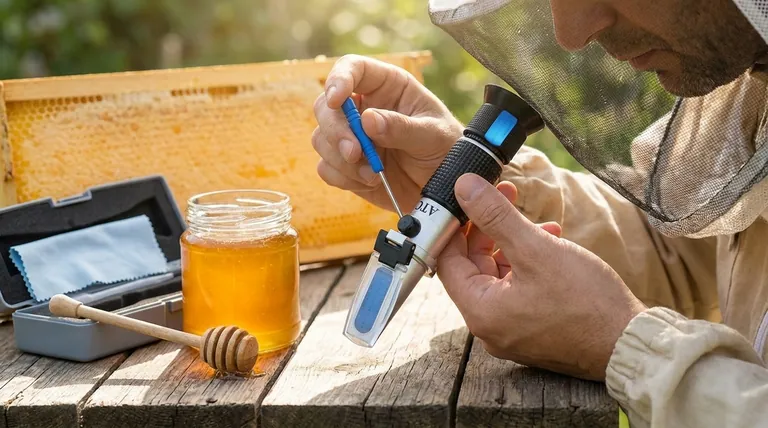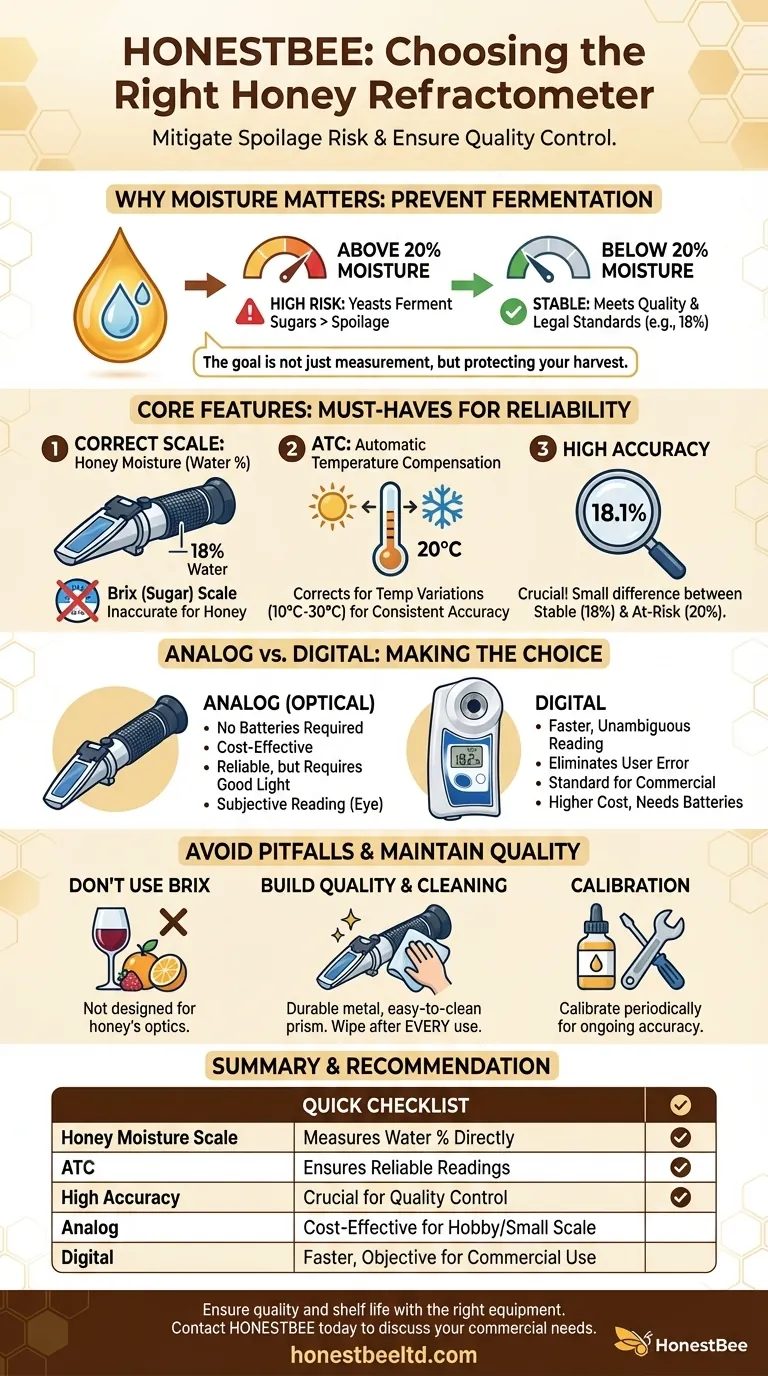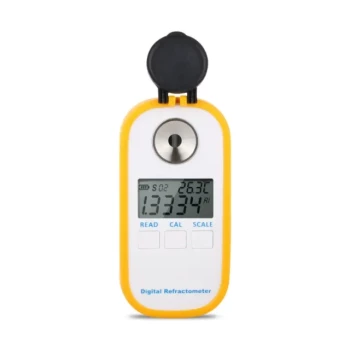When choosing a honey refractometer, the most critical considerations are ensuring it is specifically designed to measure the percentage of water in honey, has high accuracy, and includes Automatic Temperature Compensation (ATC). These three features work together to provide a reliable reading of moisture content, which is the single most important factor in determining the quality and shelf stability of your honey.
Your goal is not just to buy a measurement tool; it is to mitigate the risk of honey spoilage. A refractometer is your primary instrument for quality control, ensuring your harvest won't ferment and meets legal standards for sale.

Why Moisture Content is the Critical Metric
Preventing Fermentation
The primary purpose of measuring moisture in honey is to prevent fermentation. Naturally occurring osmophilic yeasts in honey will become active and ferment the sugars if the water content is too high.
Honey with a moisture content above 20% is at high risk of fermenting, which ruins its flavor, texture, and commercial value. Keeping it below this threshold is essential for a stable, high-quality product.
Meeting Legal and Quality Standards
For commercial producers, honey must meet specific legal standards. In many regions, the maximum allowable moisture content is around 20-21%.
Using an accurate refractometer ensures your product is legally compliant and upholds a standard of quality that customers expect.
Core Features of a Reliable Honey Refractometer
The Correct Measurement Scale
This is the most crucial consideration. You must purchase a refractometer specifically calibrated for honey moisture content (water %).
Many general-purpose refractometers measure in Brix (sugar content), which is used for wine, fruit juice, or industrial fluids. While related, a Brix scale is not a direct or accurate measure for honey moisture and will lead to incorrect conclusions.
Accuracy and Automatic Temperature Compensation (ATC)
The density of honey changes significantly with temperature. A reading taken on a cool morning will differ from one taken on a warm afternoon, even if the moisture content is identical.
Automatic Temperature Compensation (ATC) is a non-negotiable feature that corrects for these temperature variations, typically within a range of 10°C to 30°C (50°F to 86°F). Without ATC, your readings are unreliable and can give you a false sense of security.
Accuracy ensures the reading you see is true. Given that the difference between stable honey (18%) and at-risk honey (20%) is very small, a device with high accuracy is essential.
Analog vs. Digital Displays
This choice comes down to budget and user preference.
- Analog (Optical) Refractometers are less expensive and require no batteries. The user looks through an eyepiece to read where a shadow line falls on a printed scale. They are reliable but can be subjective and difficult to read in poor light.
- Digital Refractometers provide a clear, unambiguous number on an LCD screen. They eliminate user error in reading the scale, are faster to use, and are the standard for commercial operations. Their main drawbacks are higher cost and reliance on batteries.
Understanding the Trade-offs and Common Pitfalls
The Pitfall of Using a "Brix" Refractometer
The most common mistake is buying a cheaper, general-purpose Brix refractometer. These are not designed for the unique optical properties of honey. Using one will result in inaccurate moisture readings, defeating the entire purpose of testing. Always verify the product is explicitly for honey moisture.
Overlooking Build Quality and Usability
Your refractometer will be used in environments that can be sticky and messy. A well-built device made of metal with a clear, scratch-resistant prism will last longer and maintain its accuracy.
Consider how easy it is to clean. Smooth surfaces without excessive nooks and crannies will make post-use cleanup much simpler.
The Myth of Needing "Extra Features"
Some high-end digital models offer features like Bluetooth connectivity or data logging. For a small-scale beekeeper, these are almost always unnecessary. Focus on the core functions: the correct scale, accuracy, and ATC. Don't pay extra for features you will never use.
Forgetting Calibration and Maintenance
No refractometer is accurate forever without proper care. Before its first use and periodically thereafter, you must calibrate it. This is typically done with a special calibration oil (often included) or distilled water, depending on the model.
After every single use, the prism must be cleaned gently with a soft, damp cloth. Dried honey residue will skew future readings and can permanently damage the prism surface.
Making the Right Choice for Your Goal
After a brief analysis of your needs, the right tool becomes clear.
- If your primary focus is hobby or small-scale beekeeping: A durable, analog refractometer with ATC and a dedicated honey moisture scale offers the best balance of cost and reliability.
- If your primary focus is commercial production or high-volume testing: A digital refractometer is a wise investment for its speed, objectivity, and ability to eliminate guesswork from your quality control process.
Ultimately, choosing the right refractometer is an investment in the quality and longevity of your honey harvest.
Summary Table:
| Key Consideration | Why It Matters |
|---|---|
| Honey Moisture Scale | Measures water % directly; Brix scales are inaccurate for honey. |
| Automatic Temperature Compensation (ATC) | Corrects for temperature changes, ensuring reliable readings. |
| High Accuracy | Crucial for detecting the small difference between stable (18%) and at-risk (20%) honey. |
| Analog vs. Digital | Analog is cost-effective; digital is faster and easier for commercial use. |
Ensure the quality and shelf life of every honey harvest with the right equipment from HONESTBEE.
As a trusted supplier of beekeeping supplies and equipment for commercial apiaries and distributors, we provide the precise tools you need for effective quality control. A reliable honey refractometer is fundamental to protecting your product from spoilage and meeting industry standards.
Let us help you select the perfect refractometer for your operation's scale and needs. Contact HONESTBEE today to discuss your requirements and secure your wholesale supplies.
Visual Guide

Related Products
- Precision Honey Refractometer Instrument for Quality Assessment
- Digital Honey Refractometer for Precision Measurement of Optimal Honey Quality
- HONESTBEE 72 Frame Industrial Electric Honey Extractor for Beekeeping
- HONESTBEE 6 Frame Three Use Electric Honey Extractor for Beekeeping
- Plastic Hand Crank 2 Frame Honey Extractor Low Price
People Also Ask
- Why is a honey refractometer important for beekeepers? Ensure Quality and Prevent Fermentation
- What is a honey refractometer? The Essential Tool for Perfect Honey Quality
- What are the key points for proper usage of a honey refractometer? Ensure Accurate Moisture Readings Every Time
- What are the features of the Standard Refractometer for honey moisture content? Essential Tools for Quality Control
- How does a honey refractometer work? Ensure Honey Quality & Harvest Readiness



















